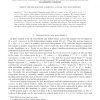Free Online Productivity Tools
i2Speak
i2Symbol
i2OCR
iTex2Img
iWeb2Print
iWeb2Shot
i2Type
iPdf2Split
iPdf2Merge
i2Bopomofo
i2Arabic
i2Style
i2Image
i2PDF
iLatex2Rtf
Sci2ools
RSA
2010
2010
The second largest component in the supercritical 2D Hamming graph
The 2-dimensional Hamming graph H(2, n) consists of the n2 vertices (i, j), 1 ≤ i, j ≤ n, two vertices being adjacent when they share a common coordinate. We examine random subgraphs of H(2, n) in percolation with edge probability p, so that the average degree 2(n−1)p = 1 + ε. Previous work [5] had shown that in the barely supercritical region n−2/3 ln1/3 n ε 1 the largest component has size ∼ 2εn. Here we show that the second largest component has size bounded by ε−2 log(nε3 ), so that the dominant component has emerged. This result also suggests that a discrete duality principle holds, where, after removing the largest connected component in the supercritical regime, the remaining random subgraphs behave as in the subcritical regime.
| Added | 30 Jan 2011 |
| Updated | 30 Jan 2011 |
| Type | Journal |
| Year | 2010 |
| Where | RSA |
| Authors | Remco van der Hofstad, Malwina J. Luczak, Joel Spencer |
Comments (0)

